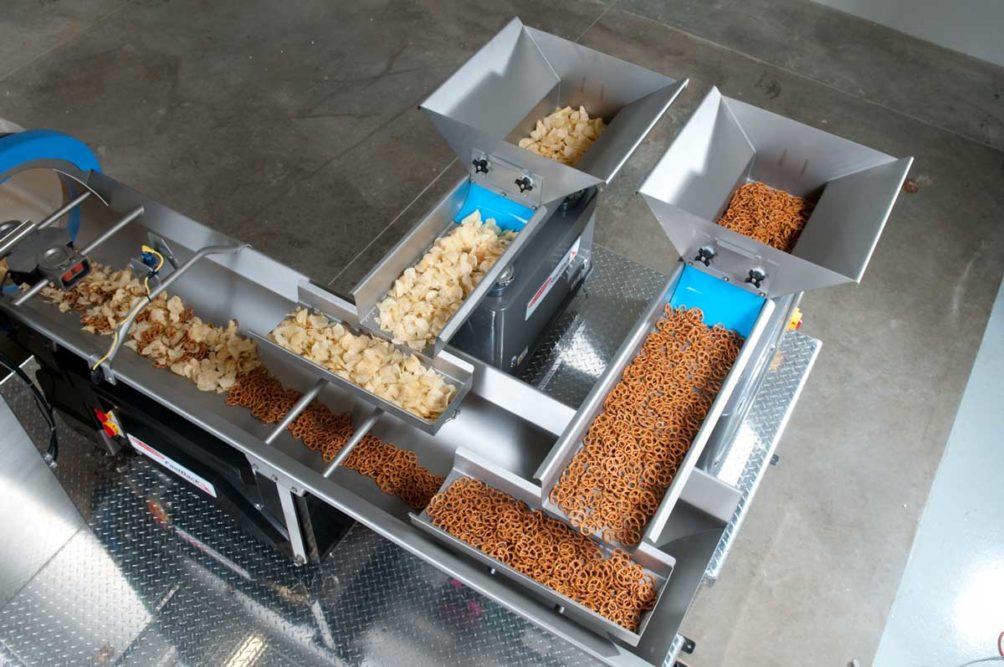For snack manufacturers, achieving balanced blends is a complex task that requires synchronization of various technologies to create ounce-perfect mixes. Any variations in the process can lead to product waste and additional costs.
Heat and Control offers several options to ensure the proper count or weight of snack mixes through its line of FastBack Blending Systems and Ishida blend/mix weighers.
FastBack handles products gently on high-resolution load cells. Its New Horizon controls with proportional-integral-derivative (PID) feedback and user-friendly operation make snack mixing reliable with less than 1.5% accuracy variation, said Brian Barr, sales manager of Heat and Control’s packaging systems division.
“Our technical sales team can assist our producer partners to determine which solution best suits their technical and commercial needs to provide a guaranteed mix result,” Mr. Barr said. “The solution can also vary based on the components themselves, as each product has different product flow characteristics.”
The FastBack systems and the Ishida blending weighers use exact weight controls in the blending process to meet package label weight requirements and recipe targets. In both systems, snack producers can weigh individual components then combine the ingredients in the final package.
“This synchronization provides consistent component streams, meters components with dependable accuracy and conveys blended components without segregation while giving operators complete and intuitive control over the entire process,” Mr. Barr said.
Upgrading tracking systems is also key to maintaining accuracy. Mark Podl, chief executive officer, Doran Scales, said operators using paperwork and a checkoff program is not enough.
“Quite often paperwork from the plant floor is a work of fiction,” he said. “Unless the operator is guided through the operation and the work is confirmed by the equipment as the operation takes place, management cannot be assured that operations are being completed accurately.”
Automating data tracking is much more reliable. Doran’s Formula Control Scale System measures each ingredient as it’s added to the batch. Exact weights and tolerances are preprogrammed into the scale system, and it does not allow operators any variations with the predetermined amounts.
“This ensures the overall snack mix has the right percentages of fruits, nuts or pretzels,” Mr. Podl said.
TNA’s automatic weigher system and its infeed can be customized to the number and type of ingredients in a mix. Anurag Mitra, product marketing manager, TNA, said software-controlled, staggered dumps give the operator the ability to control the timing of each component discharge to optimize the mix of ingredients in the package.
Filling flexibility
What makes snack mixes so popular is also what makes them so difficult to package. The wide range of ingredients means snack producers must shift from strong ingredients like nuts to more delicate ones like fruit or crackers without major holdups in production.
Mr. Barr said flexibility can be achieved with modular systems. FastBack can expand to 10 positions as needed to meet current and future requirements.
The influx of plant-based snacks is creating another challenge as snack producers include them in mixes while focusing on taste and texture. By integrated seasoning application and tumble drum mixing, Heat and Control’s patented tumble drum is designed to further improve product blends and season snacks immediately prior to packaging. The tumble drum helps consistently season the mixes and protect the varieties of products included in them, Mr. Barr added.
In the pursuit of flexibility, producers can’t sacrifice efficiency. The ability to switch between products also requires the ability to limit waste. This is especially true for more expensive premium snacks.
“Doran’s focus has been to offer our customers options that will allow them to minimize waste, especially with ingredient costs on the rise,” Mr. Podl said.
Doran’s automated systems also offer ways to prevent workforce mistakes. The company developed its systems for easy operation and to eliminate operator errors on scaling of all ingredients.
Flexibility also requires acute attention to sanitary design especially because snack mixes often contain allergens like nuts.
TNA carefully considers hygiene with its vertical form/fill/seal (VFFS) machines. They feature quick wipe-down stainless-steel surfaces to ensure equipment can be cleaned rapidly when switched from one packaging run to the next to eliminate the risk of cross contamination.
Additionally, all varieties of snack mixes are now being packed into a wider array of packages. The TNA robag series of VFFS machines can be integrated with blending weighers to produce a range of bag types, including pillow, sachet, resealable and multi-bag formats.
Consumer demand for portion control has also prompted snack producers to shrink their bag sizes to single-portion packets. Packaging systems that offer flexibility in size, ultra-high speeds and low reject rates will help manufacturers successfully implement smaller packaging sizes, Mr. Mitra said. However, he advised, when implementing single-portion packets, it is important for snack manufacturers to consider upstream equipment capacity since these systems will likely process the same capacity of product as they did previously.
“As a result, the packaging lines must be able to cope with the quantities produced when sorted into smaller pack sizes to be as efficient as possible,” Mr. Mitra said. “This means the equipment in use is the biggest obstacle to overcome when changing package sizes of savory products.”
To cope with the perpetually changing snack mix ingredients and their package sizes, snack producers should invest in equipment with production flexibility as well as equipment that complement each other’s output. That’s the key to succeeding in today’s market.
This article is an excerpt from the April 2020 issue of Baking & Snack. To read the entire feature, click here.






